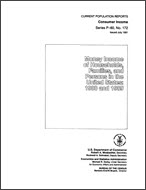Money Income of Households, Families, and Persons in the United States: 1988 and 1989
Money Income of Households, Families, and Persons in the United States: 1988 and 1989
Note
Work experience data for 1989 contained in tables 2-4, 14-16, 19, 23, and 25-32 include members of the Armed Forces. This change reflects a modification to the March 1990 income supplement questionnaire in which current Armed Forces members were asked about work experience for the previous calendar year. Tables 1 and 24, however, restrict work experience data to civilians so that year-to-year comparisons are consistent.
Some of the standard errors for income and nonincome characteristics for 1988 and 1989 have changed since first issued in the Current Population Reports, Money Income and Poverty Status in the United States 1989, Series P-60, No. 168. The changes reflect a revision to the parameters used in calculating standard errors (see appendix D, "Source and Accuracy of Estimates," table D-3).
Introduction
This report presents data on the income of households, families, and persons in the United States for the calendar years 1988 and 1989. These data were compiled from information collected in the March 1989 and 1990 Current Population Surveys (CPS) conducted by the Bureau of the Census. The surveys consisted of approximately 56,000 and 60,000 households respectively, nationwide and were designed mainly to produce reliable national estimates, though some data by region and metropolitan residence were also compiled and appear in this report.
The official income estimates in this report are based solely on money income before taxes and do not include the value of noncash benefits such as food stamps, Medicare, Medicaid, public housing, and employer-provided fringe benefits. For a discussion of the effects of taxes and noncash benefits on income, see P-60, No. 169-RD.
This report differs from previous final income reports in that the tables in this report have been redesigned and data for two income years, 1988 and 1989, are included. Table contents have been revised and expanded to reflect the changing needs of users. Income data for 1989 are presented first for households, families, unrelated individuals, and persons. Comparable data for 1988 follow these tables. Time series estimates of income for households, families, persons, and per capita income are included in appendix B. Tables B-2 through B-8 show income estimates using the CPI-U as a price deflator; tables B-9 through B-15 contain comparable income estimates using the CPI-U-X1 as a price deflator.
The text of this report begins with a section on household income containing year-to-year comparisons by region, type of household, and type of residence. This is followed by a section on changes in family income by race, Hispanic origin, and family composition. Sections on earnings of year-round, full-time workers, per capita income, and income inequality follow the family section. The report text concludes with sections on the trends in money income based on two alternative measures of inflation, the CPI-U and CPI-U-X1.
A Note on Language
Census statistics date back to 1790 and reflect the growth and change of the United States. Past census reports contain some terms that today’s readers may consider obsolete and inappropriate. As part of our goal to be open and transparent with the public, we are improving access to all Census Bureau original publications and statistics, which serve as a guide to the nation's history.
Others in Series
Publication
Publication
Publication




